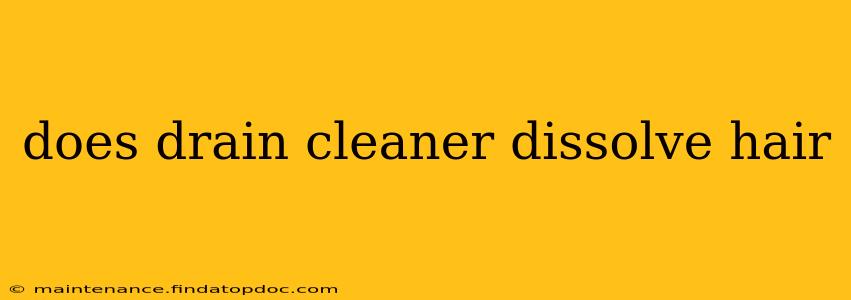Does Drain Cleaner Dissolve Hair? The Truth About Clogged Drains and Chemical Solutions
Hair clogging drains is a frustratingly common household problem. While many reach for drain cleaner as a quick fix, understanding how these chemicals work—and their limitations—is crucial. The short answer is: yes, some drain cleaners can dissolve hair, but it's not always a straightforward or safe solution.
This article will explore the effectiveness of drain cleaners on hair clogs, delve into the science behind their action, and offer safer, more environmentally friendly alternatives.
What are drain cleaners and how do they work?
Drain cleaners generally fall into two categories: acidic and caustic (alkaline). Acidic drain cleaners, often containing sulfuric acid, work by breaking down organic matter through chemical reactions. Caustic drain cleaners, usually containing sodium hydroxide (lye), are extremely alkaline and react with fats, grease, and organic materials like hair, breaking them down into smaller, more easily flushed away components.
The effectiveness of these cleaners on hair depends on several factors, including:
- The type of drain cleaner: Caustic drain cleaners are generally more effective at dissolving hair than acidic ones.
- The concentration of the active ingredient: Stronger solutions will work faster, but also pose a greater risk.
- The amount of hair: A small amount of hair might dissolve completely, while a large, compacted clog might require more aggressive methods.
- The age of the clog: Older clogs may be more difficult to dissolve due to hardening and buildup of other substances.
Does drain cleaner completely dissolve hair?
While drain cleaners can dissolve hair, they don't always completely eliminate the clog. Often, the chemical reaction breaks the hair down into smaller particles, which may still remain in the drainpipe, potentially leading to future clogs. Furthermore, the chemical reaction might not reach all parts of the clog, leaving some hair intact.
What are the risks of using drain cleaner on hair clogs?
Using drain cleaners comes with inherent risks. These chemicals are highly corrosive and can:
- Damage pipes: Especially older pipes made of materials like PVC or metal, can be corroded or weakened by strong chemicals.
- Cause injury: Contact with skin or eyes can result in severe burns. Inhalation of fumes can also be harmful.
- Harm the environment: Many drain cleaners contain harsh chemicals that can pollute waterways.
Are there safer alternatives to using drain cleaner for hair clogs?
Absolutely! Several safer and more environmentally friendly methods exist for clearing hair clogs:
- Boiling Water: Pouring boiling water down the drain can help loosen and flush away hair.
- Baking Soda and Vinegar: A mixture of baking soda and vinegar creates a fizzing reaction that can help break down clogs.
- Plunger: A good, strong plunger is often highly effective at dislodging hair clogs.
- Plumbing Snake: A plumbing snake (also called a drain auger) can physically remove hair from the drainpipe.
How can I prevent hair clogs in the future?
Prevention is always better than cure. Here are some proactive steps:
- Regularly clean drain strainers: Regularly remove and clean hair from strainers to prevent buildup.
- Use a hair catcher: Install a hair catcher in your shower or bathtub drain to prevent hair from entering the pipes.
- Avoid pouring grease or oil down the drain: These substances can combine with hair to create more stubborn clogs.
Can I use drain cleaner on other types of clogs besides hair?
While drain cleaners might work on other clogs, it's generally not recommended. The best approach is to identify the type of clog and use the most appropriate method for removal. For instance, grease clogs might respond better to boiling water or a specialized grease-cutting product.
In conclusion, while drain cleaners can dissolve hair, they aren't always the best or safest solution. The risks associated with their use, combined with the possibility of incomplete clog removal and environmental damage, make safer alternatives a much more attractive option. Consider the safer methods mentioned above and prioritize prevention to keep your drains flowing freely and efficiently.
